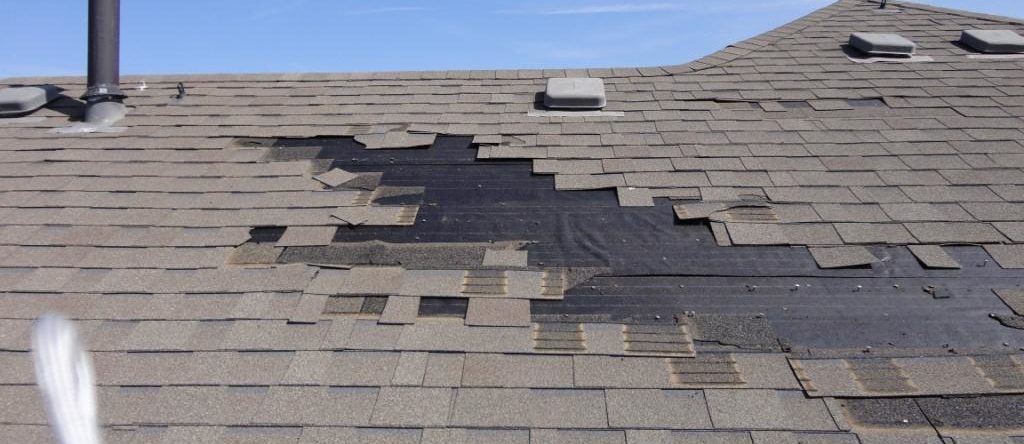Wind is a natural phenomenon that can have a significant impact on roofs and siding. High winds and weather events can cause significant damage to roofs and siding, resulting in costly repairs for homeowners. It is important to weather proof your home before major storm or weather events to prevent costly damage and subsequent repairs.
Roofing
Roofs are particularly vulnerable to wind damage. High winds can cause shingles to become dislodged or damaged, leading to leaks and water damage inside the home. The severity of the damage will depend on the strength of the winds and the condition of the roof. Homes with older roofs or poorly maintained roofs are more susceptible to wind damage.
One of the most common ways that wind affects roofs is by lifting the edges of shingles. When the wind blows across the roof, it creates an area of low pressure on the upwind side of the roof and an area of high pressure on the downwind side. This pressure difference can cause the shingles to lift and curl, making them more susceptible to damage or being dislodged. Over time, this can lead to leaks and other forms of damage to the roof.
Wind can also cause debris, such as tree branches and other objects, to impact the roof. This can cause shingles to become cracked or damaged, creating another potential point of entry for water. In severe cases, wind can even lift sections of the roof off the house, causing significant damage to the structure.
Siding
Siding is another part of the home that can be affected by wind. Like roofs, high winds can cause damage to siding, particularly vinyl siding. Vinyl siding is lightweight and flexible, which makes it vulnerable to wind damage. High winds can cause vinyl siding to warp or crack, creating gaps where wind and water can enter the home.
In addition to physical damage, wind can also cause other problems for homeowners. For example, wind can cause air to leak into the home, making it more difficult to maintain a comfortable temperature. This can result in higher energy bills as the HVAC system works harder to keep the home warm or cool. Wind can also cause noise, which can be disruptive to homeowners, particularly at night.
Protection Options
Fortunately, there are steps homeowners can take to protect their homes from wind damage. The first step is to ensure that the roof and siding are in good condition. Regular inspections and maintenance can help identify any potential problems before they become more severe. For example, homeowners can replace any damaged or missing shingles and repair any cracks or gaps in the siding.
Another way to protect the home from wind damage is to choose the right materials for the roof and siding. For example, metal roofs are more resistant to wind damage than traditional shingle roofs. Metal roofs are also more durable and require less maintenance, making them a good choice for homeowners in areas with high wind speeds.
When it comes to siding, homeowners should consider the wind resistance of the materials they choose. For example, fiber cement siding is more resistant to wind damage than vinyl siding. Fiber cement siding is also more fire-resistant and has a longer lifespan than vinyl siding.
Homeowners can also take steps to improve the wind resistance of their homes. For example, adding additional bracing to the roof or installing hurricane straps can help anchor the roof to the walls of the home, making it more resistant to wind damage. Adding storm shutters or impact-resistant windows can also help protect the home from wind damage.
In addition to these measures, homeowners should also be prepared for severe weather events. This means having an emergency plan in place and stocking up on necessary supplies, such as food, water, and medications. Homeowners should also have an evacuation plan in case it becomes necessary to leave the home.
Consider Impact Resistant Materials
You may want to consider impact-resistant options which are available in a wide range of styles, colors, and finishes, allowing homeowners to maintain the aesthetic appeal of their homes while benefiting from enhanced protection. Whether it’s replicating the look of traditional wood siding or offering a sleek and modern appearance, impact-resistant materials can be customized to complement various architectural styles.
In conclusion, impact-resistant siding and roofing could offer numerous benefits for homeowners seeking to protect their homes from wind, flying objects, hail, and weathering. These durable materials provide added safety and peace of mind during severe weather events by withstanding high winds and resisting the impact of debris. They also offer increased resilience against hail damage and exhibit superior resistance to weathering, resulting in a longer lifespan and reduced maintenance costs. Furthermore, impact-resistant options often provide better energy efficiency and come in a variety of styles to suit different design preferences. Investing in impact-resistant siding and roofing is a wise choice for homeowners looking for long-lasting protection and enhanced durability for their homes.
No matter what the season, the A&A Roofing & Exteriors team is here for you. Our team has experience working across all seasons in the Midwest climate and is able to get the job done at any time of the year.


